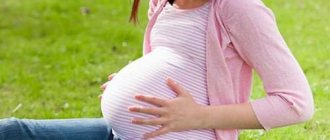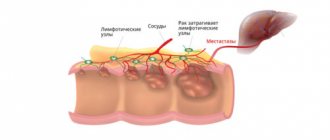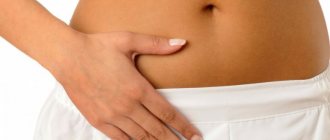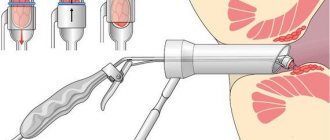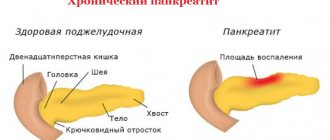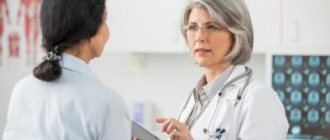The appearance of hemorrhoidal disease does not go unnoticed. As a rule, this disease is fraught with severe painful symptoms, itching, pain and many other negative manifestations that interfere with the normal way and rhythm of life. Most often, it is the fair half of the population that is susceptible to this disease due to the individual sensitivity and pliability of the body. Sometimes it is not possible to detect a disease until the disease begins to actively progress. Therefore, it is best to periodically undergo a comprehensive examination in the hospital, which will help to diagnose the disease in a timely manner and begin treatment.
Internal hemorrhoids in women - description and character
According to statistics, in the female half of the population such a phenomenon as hemorrhoids or varicose anal veins appears much more often than in men. This is primarily due to the period of pregnancy and gestation, which negatively affects women's health. There is an increased risk of inflammatory and infectious diseases associated with congestion in the rectum in women at any age.
Much more often, pregnant or lactating women experience an internal form of hemorrhoids associated with fetal pressure on the rectal area, but only a proctologist can accurately diagnose the disease and its form.
As a rule, the occurrence of such pathologies is associated with an incorrect lifestyle or a congenital tendency to form hemorrhoids. In any case, this disease requires comprehensive diagnosis and immediate treatment, because it can progress and worsen quite quickly, especially during pregnancy.
How to treat external hemorrhoids
Diseases of the rectum are among the most difficult to cure diseases. External hemorrhoids can be quickly cured only by using a full range of measures, including medications, local therapy and traditional medicine. If there is no result, surgical intervention will help get rid of the problem. Self-medication of hemorrhoids is not recommended. The process should be supervised by a proctologist.
- Snowman made from plastic cups
- Skin hyperemia - causes of redness. What is skin hyperemia and how to treat it, photo
- EEG - what kind of research is it? What does electroencephalography of the head show and how to decipher the results
Therapeutic diet
Proper nutrition is included in the treatment of external hemorrhoids and is an integral part of it. It is necessary to control the diet at any stage of the disease, and especially after surgical removal of the nodes. Constipation is considered the main factor provoking the disease. The purpose of the diet is to normalize digestion. You should eat food in small portions up to 6 times a day.
Basic principles of diet for hemorrhoids:
- Cereals, vegetables and fruits are introduced into the diet (these products normalize the digestion process and prevent constipation);
- You should eat bread only from wholemeal flour;
- It is recommended to consume only gray or dark varieties of cereals (buckwheat, oatmeal, rolled oatmeal, pearl barley);
- Bran is introduced into the diet (you should consume at least 50 g of oat, wheat or rye varieties per day; the product goes well with cereals);
- If you have hemorrhoids, you should not eat fatty foods (it is better to steam meat);
- the amount of fermented milk products consumed should be increased (to normalize digestion);
- coffee, alcohol, carbonated drinks, spicy spices, flour products, and dairy products with a high fat content should be excluded from the diet.
Drug therapy
Conservative pharmacotherapy is the main method of treating rectal diseases. It is used for any form of hemorrhoids. The complex of medications includes agents with hemostatic, analgesic, anti-inflammatory and phlebotonic effects. After a course of getting rid of hemorrhoids, it is recommended to take special preventive medications. All means of combating hemorrhoids are presented in three groups: creams, suppositories, and oral medications.
Creams, ointments and gels
The most effective means for external use include:
- "Venoruton" (affects the condition of blood vessels, used at least three times a day).
- “Relief” (relieves symptoms of irritation).
- Zinc ointment (heals wounds).
- “Antihemorrhoids” (relieves swelling, heals wounds).
- Heparin ointment (has an analgesic effect).
Rectal suppositories
Medicines for hemorrhoids differ in composition: individual components help cope with pain, speed up the healing process of wounds, and have an antiseptic effect. Reviews from patients are uneven: some like one thing, while others like the opposite group, but the main thing here is the quick effect on the disease and pain relief. In some cases, considerable time is spent searching for suitable rectal suppositories. Glycerin-based products are considered the most convenient to use. Rectal suppositories, which are recommended by experts:
- "Nigepan" (the drug has an analgesic effect).
- “Anuzol” (belladonna extract heals wounds and cracks).
- "Gepazolone" (suppositories prevent the formation of blood clots).
- “Relief” (a special component is shark liver oil, which has a number of beneficial properties).
Medicines for oral administration
Popular pills for hemorrhoids:
- “Detralex” (phlebotropic drug, effectively eliminates the symptoms of acute and chronic hemorrhoids, the course of treatment has specific dosage - first, the drug is taken twice a day, three tablets, after four days - two tablets twice a day).
- "Venoruton" (an effective remedy, but has a number of contraindications, for example, it is not suitable for the treatment of hemorrhoids in pregnant women).
- "Euscusan" (plant-based product, has an analgesic effect).
- “Ibuklin” (the drug is particularly effective for exacerbations of rectal diseases).
Surgical intervention
When external hemorrhoids become complicated, a special operation is performed: thrombotic masses or hematomas are surgically removed. In rare cases, doctors recommend completely cutting out the thrombosed node with the affected vein. The rehabilitation period is characterized by the presence of many nuances. The operation is performed under local anesthesia and does not take much time from specialists. Surgery is a last resort measure used in cases where it becomes impossible to cure external hemorrhoids at home.
- Is it possible to get pregnant with interrupted intercourse?
- Fondue - what is it: recipes with photos
- Causes of chest pain
Main symptoms of internal hemorrhoids
The internal form of hemorrhoids is characterized by the formation of hemorrhoidal cones on the inside of the anus, under the mucous membrane of the colon, and it is their location that explains the particular pain and severity of the symptoms.
The main manifestations of the internal form of the disease include:
- feeling of bulging of the anal passage;
- unpleasant sensation of a foreign object in the anus;
- thrombus formation;
- development of cracks and wounds on the walls;
- severe pain syndrome;
- severe itching, burning and stinging;
- periodic bleeding during bowel movements;
- pinched muscles during bowel movements;
- nodes falling out.
In fact, the symptoms of this disease can vary depending on the form and stage of development of hemorrhoids; the more complex and advanced the course of the disease, the more painful and serious the manifestations become. As a result, in case of acute, advanced internal hemorrhoids, the only way to get rid of it is surgical intervention.
Physiology of educational problems and factors provoking its development
The development of hemorrhoids occurs as a result of stagnation of blood in the pelvic organs. As a result, the blood circulation of organs and tissues located in the corresponding area is disrupted. Lack of nutrition leads to deformation of blood vessels and partial loss of their elasticity. Under the influence of provoking factors, such problems immediately make themselves felt, leading to the appearance of cracks in the anus and the formation of hemorrhoids.
The formation of the disease does not occur instantly, and in the initial stages it can be completely asymptomatic. As a rule, its development requires several years, during which the body is systematically negatively affected by a certain property.
Provoking factors of this kind include the following:
- sedentary lifestyle;
- increased body weight;
- presence of bad habits;
- systematic stress;
- overwork;
- frequent constipation;
- changes in hormonal levels;
- metabolic disease;
- diseases of the cardiovascular system;
- sedentary work.
The above conditions can provoke poor circulation in the pelvis and lead to the formation of hemorrhoids. However, its development is rather slow, even despite the influence of provoking factors.
Primary signs of a problem can cause some discomfort to a person, and ignoring them inevitably leads to aggravation of the situation and the development of complications. Today, in medical practice, two types of hemorrhoids are distinguished: external and internal.
Causes of hemorrhoids in women
The fact that the internal form of hemorrhoidal disease most often affects the female part of the population does not mean that among the possible influencing factors there is only pregnancy. The causes of the disease in women can be the same as in men:
- lifting heavy weights;
- high physical activity;
- excess weight;
- passive lifestyle;
- physical labor;
- frequent drinking and smoking;
- internal inflammatory processes of organs;
- prolonged sitting or standing;
- frequent constipation, diarrhea, diarrhea;
- problems with bowel movements;
- factor of heredity and genetic predisposition.
In addition, the appearance of internal hemorrhoids can be promoted by excessively frequent consumption of hot drinks and spicy foods, as well as a strict diet or frequent consumption of foods that provoke the development of the disease.
Lifestyle
A common cause of the external form of the disease is excessive strain during bowel movements. Difficult bowel movements occur when there is a lack of plant fiber and a violation of intestinal symbiosis. The problem is solved by daily consumption of fresh fruits, vegetables, cereals, and dairy products.
Fiber stimulates intestinal motility and is a nutrient substrate for beneficial bacteria. To soften stool, you should drink at least 1.5-2 liters of liquid per day. Also, if you have external hemorrhoids, you should not lift heavy objects, sit or stand for long periods of time.
Treatment of external hemorrhoids at home is aimed at preventing thrombosis of nodes, relieving inflammation, swelling, and pain. The use of ointments, tablets, suppositories and traditional methods at home inhibits the progression of the disease. Dietary nutrition with an increase in the proportion of plant fibers and adequate physical activity will increase the effectiveness of medicines.
We recommend: Do people with hemorrhoids join the army and what categories of suitability exist?
Congenital and physiological causes
In addition to defects in lifestyle, behavior and nutrition, there is also a category of causes of internal hemorrhoids associated with congenital factors and the physiology of the female body.
Similar reasons that provoke the occurrence of the disease include:
- pathologies of female genital organs;
- menstruation;
- pregnancy;
- frequent stress, breakdowns and neurological diseases;
- lack of vitamins and vital components in the body;
- frequent anal sex.
In addition, the period before and after the birth of a child is considered particularly sensitive. It is during this period that a woman’s risk of internal hemorrhoids is much higher than in normal days of life.
Why are external hemorrhoids dangerous?
Pathology in any form - both internal and external hemorrhoids in women - poses some danger to the health and life of the patient. At any time, under the influence of negative provoking factors, the disease can become more severe and complications can form.
The most common is thrombosis of varicose nodes and plexuses - the symptoms of external hemorrhoids in women become most pronounced:
- sharp pain in the anal area;
- increasing swelling of protruding “bumps”;
- local or general increase in temperature;
- a sharp deterioration in general health - weakness, sweating, tachycardia;
- significant difficulty going to the toilet.
The lack of full medical care and comprehensive treatment leads to the fact that a blood clot from the rectal area moves to other organs and systems, with the emergence of a focus of ischemia in them - a heart attack or stroke.
In some cases, external hemorrhoids in women are complicated by massive bleeding due to trauma to the nodes. Venous blood does not just settle in streaks on the stool during defecation, but pours out in a stream. This condition requires immediate surgical intervention.
Another common complication of the disease is the spread of the inflammatory process to the fatty tissues surrounding the rectum - paraproctitis. The focus of pus transforms into an abscess with the corresponding clinical picture - a sharp rise in temperature, intense pulsating pain, severe general intoxication. Relief of well-being occurs only as a result of complex treatment.
Nature of symptoms and complexity of the disease
When developing internal hemorrhoids, it is important to pay special attention to the nature of the pain syndrome, the frequency and location of its occurrence, since this may indicate the stage of the disease. The pain of hemorrhoids can be dull and bright, it can appear periodically or accompany the patient constantly.
As a rule, pain with internal hemorrhoids can appear:
- in the lower abdomen - often manifests itself in the form of spasms and twitching;
- in the groin area - characterized by severe spasms, twitching, accompanied by nausea and periodic vomiting;
- in the lumbar region - they are distinguished by stagnation, hinder movement, and do not allow sitting and standing;
- in the anal area - characterized by stiffness, tightening of the sphincter, problems with defecation;
- in the intestinal area - appear due to its swelling, stretching and expansion, creating the impression of a foreign object inside;
- in the area of the formation of cones - they are distinguished by sharp pain, cutting, itching, burning, and provoke acute attacks of pain when moving;
- in the head - serves as a symptom of anemia.
The sooner the symptoms of an internal disease are detected, the greater the chances of successfully overcoming the pathology and avoiding serious consequences for the body. It is worth noting that the symptoms and external manifestations of the disease may change and become more pronounced depending on the form of the stage of development of the disease.
First stage
When hemorrhoids form at the initial stage, women may experience mild symptoms and inconveniences, which do not always allow the disease to be diagnosed in time.
At the initial stage of development, internal hemorrhoids manifest themselves as follows:
- bloody spots on toilet paper and in stool;
- pain when going to the toilet;
- discomfort and tightness of the anus;
- feeling of a foreign object in the anus;
- itching, burning;
- aching pain;
- stool with mucus discharge.
As a rule, at the initial stage of appearance, internal hemorrhoids are much easier to treat than when they progress. Therefore, it is recommended not to hesitate or delay treatment.
Symptoms
The disease is accompanied by symptoms that clearly distinguish hemorrhoids from other diseases:
- first of all, this is discomfort in the anus, plus, the anus may itch;
- the anus bleeds, traces of blood remain on the toilet paper;
- fissures in the anus;
- a feeling of “fullness” of the anus with something foreign;
- acute pain during bowel movements;
- inflammation of the veins in the rectal area.
However, these are rather initial symptoms. In the following stages, a woman may be bothered by hemorrhoids, which, increasing in number and size, cause increasingly unpleasant sensations. All this is accompanied by pain and burning. The anus area becomes red and swollen, and inflamed hemorrhoids may prolapse. In this case, you need to consult a proctologist who will prescribe the correct treatment. Often girls are embarrassed to go to the doctor with a similar problem, because they are very shy. However, with timely treatment, complications can be avoided, for example, the disease becoming chronic.
Disease progression
If you do not pay attention to the discomfort of hemorrhoids at the initial stage, the disease will develop quite quickly, and its symptoms in women will become much brighter and more noticeable.
At the progressive stage of development of internal hemorrhoids, the following appear:
- pain and discomfort when sitting or standing;
- formation of inflammatory and infectious processes;
- worsening swelling of the anus;
- increased bleeding, excessive blood loss during bowel movements;
- severe pain and stinging when going to the toilet;
- feeling of incomplete bowel movement;
- pinching of muscles in the area of knot formation.
This form of hemorrhoidal disease is already considered dangerous to health and can lead to serious pathologies in the functioning of internal organs and the colon. Therefore, it requires immediate medical treatment.
Treatment of hemorrhoids in women and men: directions of complex therapy and its purpose
External hemorrhoids can occur equally in both men and women. Moreover, its treatment is based on identical principles and involves the use of an integrated approach consisting of several equivalent areas. The composition of therapy should be determined by a doctor based on the clinical picture of the course of the disease and the intensity of its manifestations. At the same time, any self-medication is strictly prohibited, since it can lead to a significant aggravation of the situation and suppuration of hemorrhoidal cones.
Treatment of hemorrhoids in men and women is carried out according to absolutely identical principles, although it contains its own specific features.
Complex therapy may include the following areas:
- drug effects;
- preventive actions;
- folk remedies;
- surgical intervention.
Each of these vectors can be used to treat manifestations of hemorrhoids. At the same time, their prescription is carried out by the attending physician based on the structure of the manifestations of the problem. Its timely diagnosis makes it possible to get by with little and save a person from the symptoms of hemorrhoids with the help of preventive measures. Worsening symptoms, accompanied by a significant increase in cracks, require the use of medications, and the loss of lumps and their suppuration requires surgical intervention.
Treatment of hemorrhoids aims not only to suppress the symptoms of the disease, but also to get rid of the root cause of its formation. To neutralize the manifestations of the disease, various medications or folk remedies are used, and in extreme cases, surgery. At the same time, eliminating the cause of the development of the disease is entrusted to preventive measures designed to strengthen the body.
The criteria for getting rid of hemorrhoids are identical for men and women; the only factor contributing to the introduction of specific measures is hormonal disorders. In such a situation, corrective hormonal agents are prescribed, which include testosterone and estrogen. In all other cases, therapy for the disease is based on the use of the same means.
Acute and chronic form of the disease
With excessive neglect, internal hemorrhoids over time acquire an acute, chronic form, which is fraught not only with a serious health risk, but also with a pronounced aggravation of symptoms.
In this case, the following is added to the list of signs of the disease:
- hyperemia;
- heaviness in the abdomen and stomach;
- sudden changes in body temperature;
- anemia;
- heavy bleeding;
- terrible pain making it impossible to defecate;
- confluence of hemorrhoids;
- prolapse of the lower intestine;
- infection of the body and sepsis;
- severe weakness and vomiting.
As a rule, a person in this condition must be hospitalized immediately. In particularly advanced cases, drug treatment may not help, so the only treatment option at the acute stage is surgery to remove the nodes.
Effective natural ingredients to combat the external form of the disease
The doctor, talking about how to treat external hemorrhoids at home really quickly in men and women, will dwell on the list of the most useful medicinal herbs and plants. It opens with aloe juice, used fresh or in the form of a decoction. To prepare it, take 8-10 leaves, which are then cut into many pieces. Place everything in a deep container, and then pour in 1 liter of cold water. The resulting mixture is sent to a water bath for 30 minutes.
Once the composition has acquired a homogeneous consistency, it is allowed to cool slightly. Take a piece of gauze, folded 4-5 times, and soak it in the contents of the container. Soaked gauze is carefully applied to the affected area. The duration of one procedure is 15 minutes.
The list of medicinal herbs and plants continues with the following gifts of nature:
- Birch tar is known for its high concentration of antimicrobial, anti-inflammatory and regenerating components. Regular baths are based on it. To prepare it, take 2 liters of hot water, to which add 1 tbsp. l. tar. You can sit in such a bath only after a person checks the water temperature. It shouldn't be too cold or hot. Duration of 1 procedure – up to 20 minutes. It can be completed earlier if the water has cooled.
- Oak bark is widely used in medicine due to its astringent properties. Has a beneficial effect on the mucous surfaces of soft tissues. A layer of protective film is formed on their surface.
- Wild strawberry – leaves will be needed to prepare tinctures, baths and enemas.
- Potatoes are used for self-treatment of external hemorrhoids at home, from which the juice is quickly squeezed out.
Chamomile has an anti-inflammatory effect
Chamomile, a representative of the plant world, has many benefits. Anti-inflammatory and antimicrobial effect, accelerating the process of repairing damaged tissues, getting rid of spasms, and so on.
Stage of development of the disease and consequences
There are 4 possible stages of development of internal hemorrhoids. Depending on the stage of progression of the disease, its main symptoms and possible effect on the patient’s body, as well as the treatment method, are determined:
- The first stage is characterized by mild and almost imperceptible symptoms; at this stage there is slight swelling of the anus, muscle weakness, swelling and enlargement of the anal veins, irritation of the mucous membrane;
- The second stage - there is an increase in size and growth of hemorrhoids, swelling, pain and tightness, severe discomfort when going to the toilet, itching;
- The third stage is considered a transition to an aggravated form with serious symptoms, characterized by severe pain, the appearance of rectal bleeding, pinched hemorrhoids, a decrease in the anal canal of the intestine and the difficulty of bowel movements, prolapse of the nodes with a strong load on the intestines;
- The fourth stage is considered a pathologically dangerous, chronic form of the disease, with serious consequences for the body, leading to intoxication, nausea and vomiting, anemia, acute pain and blood loss, the development of erosion of the walls of the anus, inflammation, and possible prolapse of the lower intestine.
As a rule, the doctor’s treatment of the disease, as well as the duration and specificity, will completely depend on the form, stage of development of the disease, as well as the individual characteristics of the patient’s body.
Risks and possible complications in women
There are often cases of complications when treating internal hemorrhoids in women. Due to the individual characteristics of the body, untimely treatment or ignoring the recommendations of a proctologist, the disease can progress and lead to complications, including serious pathologies.
An advanced form of internal hemorrhoids can serve as a trigger mechanism for the following problems:
- enterocolitis;
- colitis of an ulcerative-spastic nature;
- polyps in the intestines;
- sepsis or purulent formations in the rectum;
- development of cancer;
- paraproctatitis.
In addition, as the disease progresses, problems in intimate life, depressive states, emotional disturbances, intestinal disorders, fistulas, as well as the formation of prolonged bleeding leading to weakness and loss of consciousness may occur.
Why do women get hemorrhoids?
The disease is characterized by deterioration of blood circulation, which ultimately leads to the formation of nodes (the venous formations of the rectum expand). In most cases, hemorrhoids in women appear due to congenital weakness of the vascular walls. When the body is in this state, it becomes vulnerable to the following risk factors:
- Periods of pregnancy, childbirth and breastfeeding
- Menstruation (blood circulation in the pelvic area intensifies)
- Sedentary lifestyle, obesity
- Poor nutrition (including debilitating diets)
- Constant constipation
- Alcohol abuse and smoking
- Inappropriate lifting of weights at home
- Weightlifting, bodybuilding and powerlifting
- Professional working conditions involving prolonged static positioning (drivers, programmers, office workers, hairdressers, accountants)
- Chronic diseases of the pelvic organs, leading to compression of blood vessels
- Hereditary vein malformations (absence of valves)
- Frequent anal sex
- Constant stress, disrupted sleep patterns
- Oncology and blood diseases
- Old age (due to natural aging processes)
What are the reasons for the development of hemorrhoids in women? During pregnancy, the uterus becomes large, putting pressure primarily on the soft tissues of the small pelvis, in the thickness of which there are vascular formations, after which blood circulation is disrupted. This leads to stagnation in the veins of the rectum, which contributes to the formation of hemorrhoids.
Progesterone, which is the “pregnancy hormone,” also reduces vascular tone.
During the process of childbirth, the female body makes enormous efforts to give birth to the fetus; pushing is accompanied by an increase in intra-abdominal pressure. In this case, the condition is aggravated by possible injuries and subsequent weakness of the musculo-ligamentous apparatus. During the lactation period, a nursing mother often neglects her health, and all her time is occupied by the child, so a visit to the doctor is usually postponed indefinitely.
The second major risk factor is constipation. These can be caused by dietary errors, excess weight, physical inactivity, diseases of the gastrointestinal tract and many other reasons. The mechanism is similar to pushing during childbirth and is associated with an increase in pressure in the abdominal cavity, as well as constant intoxication of the body.
Diagnosis and treatment
Sometimes, in order to correctly diagnose a disease, much less determine its form, a simple examination by a proctologist is not enough. As a rule, at the appointment, the doctor first conducts a survey, finds out the symptoms that are troubling the patient, examines the anal passage, as well as finger examinations in order to determine inflammation and tricky formations. After this, the proctologist prescribes a number of mandatory examinations to the patient:
- anoscopy – visual inspection and study of the walls of the colon to detect microcracks, wounds and inflammation;
- sigmoidoscopy - performed using a specialized device, which is located inside the rectum, it allows you to determine the condition of the intestinal mucosa, the presence of lumps and tricky formations, cracks, blood clots, as well as other pathological phenomena;
- Colonoscopy is an endoscopic examination of the rectum. Its walls and mucous membrane make it possible to detect tricky formations even at the initial stage of development, the presence of inflammation, irritation, swelling and tumors.
After the patient has passed all the tests and undergone hardware diagnostic procedures, a qualified proctologist prescribes complex therapy depending on the form and stage of progression of hemorrhoids.
Therapy for internal hemorrhoids in women
There are various methods for treating the internal form of hemorrhoids in women. For this purpose, complex drugs with a venotonic and antiseptic effect can be taken. Such good results in this case were shown by traditional methods of treatment, but they are effective only at the early stage of the disease. In addition, as recommended by doctors, simple treatment measures at home, when used regularly, can help reduce the manifestation of the disease.
Such measures may include:
- healthy lifestyle without bad habits;
- passion for physical activity, performing exercises against hemorrhoids;
- herbal and soda baths;
- moderate nutrition;
- weight loss (if the cause of hemorrhoids is excess weight);
- prevent constipation;
- maintain personal hygiene;
- do not neglect wound-healing ointments, natural compresses and lotions.
As for the complex therapy of hemorrhoids, it cannot do without the use of suppositories, wound-healing gels, painkillers, as well as the periodic use of enemas to facilitate bowel cleansing. It is recommended to seek help in choosing medications from your doctor.
Treatment of external hemorrhoids
External hemorrhoids occur in both women and men
The first thing the patient needs to do is see a proctologist, since only a specialist doctor can provide real help in the fight against external hemorrhoids. Treatment of the disease is, in most cases, the same for both men and women.
The most effective treatment option for this disease is considered to be a comprehensive method, when in addition to drug treatment, various traditional methods are used, switching to proper nutrition and exercise.
There are different ways to deal with external hemorrhoids, one of them is hirudotherapy - the use of leeches to treat the disease. This method is good because as a result, inflammation and pain go away more quickly, and the size of hemorrhoids decreases. Also, the use of leeches helps reduce the possibility of relapse of the disease and removes blood stagnation. This method may seem rather unusual and for good reason, but, nevertheless, it is quite effective.
Pregnant women, as well as mothers who are breastfeeding, should be treated slightly differently than other patients. The main thing to remember is that when treating this group of patients, it is permissible to use drugs consisting of natural ingredients. The following ointments can be used to treat external hemorrhoids in pregnant and breastfeeding mothers:
- Heparin ointment. It copes well with inflammation and pain, removes various formations that appear in the external form of hemorrhoids. It is especially effective in the early stages of the disease.
- Troxevasin. It relieves pain, relieves the patient from swelling after just a few uses, and reduces the amount of mucous discharge from the anus. Most often used for hemorrhoids that do not heal well.
- Relief. With its help you can get rid of bleeding and swelling, pain during bowel movements, as well as itching in the anus. It has a good effect only in the first stages of the disease.
There are also many other ointments that contain various natural elements. The main thing to remember is that this disease is easily treated in the early stages, but in advanced cases it is not so easy to cope with. Traditional medicine in some cases is also effective in combating the disease. For example, a homemade ointment containing propolis and olive oil is effective in treating the first stage of the disease. In order to prepare it, you need to grind dry propolis using a grater, add oil in a ratio of 1 to 10, and then melt it all over steam. When the ointment has cooled, it can be applied a couple of times a day.
Traditional medicine also suggests using various steam and water baths to enhance the effect of ointments, which can be based on herbs such as chamomile, St. John's wort, oak bark, and plantain. A decoction is prepared from them and when it cools a little and becomes acceptable hot, they sit in it for a quarter of an hour. This method is effective in the early stages of the disease and should be used for at least a month.
External hemorrhoids are treated in different ways, and ideally - with a complex of different approaches, which must be selected by a medical specialist.
External hemorrhoids are one of the forms of hemorrhoids, which is characterized by the appearance of compactions and formations in the anal area. In the early stages, it does not cause much discomfort to the patient, but, nevertheless, the sooner it is cured, the better. Timely treatment will reduce the likelihood of complications and is much easier than treating hemorrhoids in advanced forms.
What are hemorrhoids and how to treat them? And how can it not be treated? Look for answers in the video consultation:
When the veins of the rectum are damaged, external hemorrhoids progress, the symptoms of which can be productively eliminated using conservative methods and folk remedies. The disease is chronic, the main goal of treatment is to relieve inflammation and pain, and reduce the number of relapses. More often the disease develops during pregnancy, but occurs in other categories of patients. If the external hemorrhoid is inflamed, act immediately.
